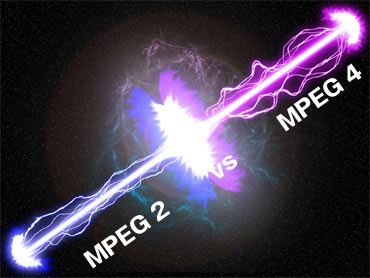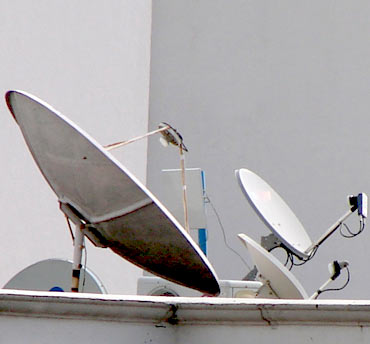
Get Ahead reader Vijay Padiyar lucidly explains and compares the difference between MPEG-2 and MPEG-4 technologies offered by direct-to-home operators in India and explains what subscribers need to find out before choosing one of the two platforms.
There are two technologies being used by Direct-To-Home (DTH) TV service providers in India and the world over, namely MPEG-2 and MPEG-4.
In India, Tata Sky and Dish TV were the first to start DTH operations, and therefore used MPEG-2. Later came Airtel Digital TV, Reliance Big TV, Sun Direct and others who had the luxury of choice and went with the newer MPEG-4 standard.
The newer DTH operators have been using this difference to their advantage by claiming that they offer superior audio and video quality due to the use of the more efficient MPEG-4 standard.
But does the use of MPEG-4 automatically imply a better quality of audio and video than MPEG-2? Or is this just a marketing gimmick aimed at getting mileage out of a newer technology that isn't necessarily better?
As always, let's start with the basics.
Click NEXT to read more.
with the subject as 'I'm a tech wizard' and we will get in touch with you.

Why do we need video compression?
The raw video stream generated by video cameras is of extremely high quality and would require a large amount of disk space for storage as well as a large bandwidth for transmission. To be able to carry video in a digital TV channel's bandwidth or transfer it over the Internet, as well as to allow storing it in CDs and DVDs, this high quality video stream needs to be 'compressed' by removing redundant audio and video data. This is precisely the job of MPEG-2 and its successor, MPEG-4.
This is somewhat similar to how we compress document files on our computer using WinZip, although of course compressing audio and video presents a different set of challenges as compared to compressing text and images in a document.
To compare MPEG-2 and MPEG-4, we will first need to understand the basics of both technologies.
Click NEXT to read more.
Check out: The all new Gadgets and Gaming page
Reader invite
Are you a gadget/gaming wizard? Would you like to write on gadgets, gaming, the Internet, software technologies, OSs and the works for us? Send us a sample of your writing to gadgetsandgaming@rediffmail.com with the subject as 'I'm a tech wizard' and we will get in touch with you.

MPEG-2
MPEG-2 was developed and finally introduced in 1999 in response to the need to compress audio/video for storage in portable digital media as well as for use in digital TV broadcast applications.
A video is basically a collection of 25 'frames' per second, each frame being like a single still image. To compress a raw video stream, MPEG-2 divides it into 'reference' and 'offset' frames.
A reference frame (called an I-frame) is basically a compressed version of the original video frame. It is similar to compressing a single bitmap (BMP) image into a JPEG image. An offset frame (called a P-frame), on the other hand, only contains information about the change in the picture information between the previous and the current video frame.
If looked at in isolation, a P-frame would not make any sense at all, because all it has is co-ordinates of which portions of the previous frame to shift and by how much.
In other words, while an I-frame is an image in itself, a P-frame only tells us how to recreate the current frame by slightly shifting parts of the previous frame. Such a scheme delivers a huge amount of compression by encoding only the change information instead of the complete frame.
So, for example, if a video of a man walking against a stationary background is to be compressed, the first frame of the original video will be converted to an I-frame, whereas subsequent frames will be converted to P-frames carrying only the change from the previous frame (in this case, the movement of the man across the screen).
Click NEXT to read more.
Check out: The all new Gadgets and Gaming page
Reader invite
Are you a gadget/gaming wizard? Would you like to write on gadgets, gaming, the Internet, software technologies, OSs and the works for us? Send us a sample of your writing to gadgetsandgaming@rediffmail.com with the subject as 'I'm a tech wizard' and we will get in touch with you.

MPEG-4
MPEG-4 was introduced in 1999 and had a wider mandate than MPEG-2. Apart from being able to compress audio/video, it was also designed to support:
Also, since the number of Internet-enabled mobile devices (such as 3G/GPRS mobile phones) were increasing, and since disk space would typically be low on these devices, MPEG-4 was also required to be more efficient at compressing video than MPEG-2.
It achieves this through the use of more advanced compression techniques, which allow efficient compression over a wide range of bit rates while maintaining a reasonably good video quality. By contrast, the video quality in MPEG-2 deteriorates as the bit rate goes down.
This feature of MPEG-4 makes it suitable for a wide range of applications, such as digital TV broadcasting, DVD storage, streaming videos over the Internet, video conferencing and video telephony.
Click NEXT to read more.
Check out: The all new Gadgets and Gaming page
Reader invite
Are you a gadget/gaming wizard? Would you like to write on gadgets, gaming, the Internet, software technologies, OSs and the works for us? Send us a sample of your writing to gadgetsandgaming@rediffmail.com with the subject as 'I'm a tech wizard' and we will get in touch with you.

Comparison
By now, it is obvious that MPEG-4 is indeed superior to MPEG-2 when it comes to audio/video compression. However, the degree of superiority depends on:
In other words, a video compressed with MPEG-4 at a given bit rate will be of better quality than if it is compressed with MPEG-2 at the same bit rate. However, a MPEG-4 compressed video at a lower bit rate will not necessarily be better than a MPEG-2 compressed video at a higher bit rate.
Not just that, MPEG-4 also makes it easier for a DTH operator to offer interactive services to its subscribers.
Click NEXT to read more.
Check out: The all new Gadgets and Gaming page
Reader invite
Are you a gadget/gaming wizard? Would you like to write on gadgets, gaming, the Internet, software technologies, OSs and the works for us? Send us a sample of your writing to gadgetsandgaming@rediffmail.com with the subject as 'I'm a tech wizard' and we will get in touch with you.

Implications for DTH services
So does this mean you should automatically go in for a MPEG-4 DTH service such as Airtel Digital TV or Reliance Big TV? Not necessarily.
In DTH, TV signals are beamed in digital format from a satellite in space to a dish antenna fitted on top of your house and connected to your set-top box. To do this, the DTH operator must rent transponders on a satellite and then position their dish antennas to point to that satellite.
Each transponder on the satellite has a fixed amount of bandwidth. The number of channels each transponder can carry depends on the bit rate of the individual channels. If the transponder's bandwidth is 48 Mbps and every channel on it is encoded at 2 Mbps, the transponder will be able to carry 24 channels.
Now, since MPEG-4 delivers better compression than MPEG-2, a DTH operator may choose to reduce the bit rate of the individual channels, so as to fit more channels into a single transponder's bandwidth. In the above example, by reducing the bit rate of each channel to 1.2 Mbps, the DTH operator can now fit 40 channels on each transponder!
And as explained earlier, a MPEG-4 channel encoded at 1.2 Mbps may not necessarily appear better than a MPEG-2 channel encoded at 2 Mbps.
Click NEXT to read more.
Check out: The all new Gadgets and Gaming page
Reader invite
Are you a gadget/gaming wizard? Would you like to write on gadgets, gaming, the Internet, software technologies, OSs and the works for us? Send us a sample of your writing to gadgetsandgaming@rediffmail.com with the subject as 'I'm a tech wizard' and we will get in touch with you.

In short, MPEG-4 offers a choice to the DTH operator. They can now either:
So, as a consumer, before choosing a MPEG-4 DTH operator, it is essential to know whether the operator is passing on the qualitative benefits to you or retaining them to save money for itself.
That apart, factors such as pricing of channels, quality, ease-of-use and responsiveness of the Set Top Box (STB), as well as quality of customer service also need to be considered while choosing a DTH service.
Bottom-line: Don't get lured by advertisements or tall promises. The best way to decide is to go to a showroom, ask for a demo and judge for yourself.
Closing Note
It is clear that as High Definition (HD) channels become more popular, the existing MPEG-2 operators will be forced to switch to MPEG-4 services to put their existing transponders to more efficient use. When this happens, the DTH operator will probably offer to replace your MPEG-2 STB with a MPEG-4 STB free of cost.
Click NEXT to read more.
Check out: The all new Gadgets and Gaming page
Reader invite
Are you a gadget/gaming wizard? Would you like to write on gadgets, gaming, the Internet, software technologies, OSs and the works for us? Send us a sample of your writing to gadgetsandgaming@rediffmail.com with the subject as 'I'm a tech wizard' and we will get in touch with you.